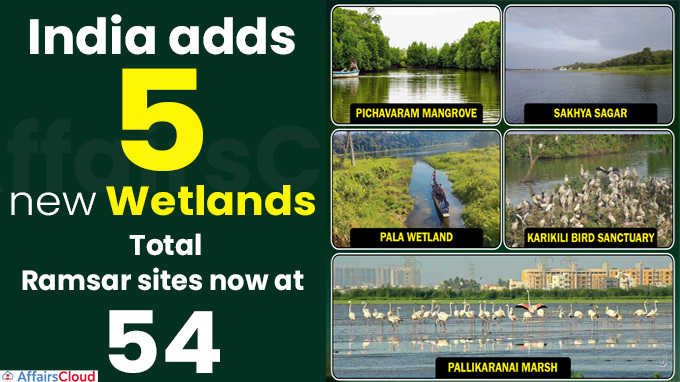
India has designated five new wetlands of international importance, taking the total number of Ramsar sites in India to 54 from 49 under the Ramsar Convention or the Convention on Wetlands. The new sites include three wetlands in Tamil Nadu (TN), one in Mizoram and one in Madhya Pradesh (MP) which are explained as below:
i.Karikili Bird Sanctuary in TN: Located in Kanchipuram district, 86 kms from Chennai, it has an area of 61.21 hectare (ha) and a belt of 5 kms width around. Its forest type is a tank having a compact grove of Barringtonia and Acacia nilotica trees Dry evergreen scrub and thorn forests.
ii.Pallikaranai Marsh Reserve Forest in TN: It is one of the last remaining natural wetlands of Chennai located adjacent to the Bay of Bengal.
iii.Pichavaram Mangrove in TN: The Pichavaram Mangrove is the second largest mangrove forest in the world covering about 1,100 hectare of area. It is separated from the Bay of Bengal by a sandbar.
iv.Pala wetland in Mizoram: It is the largest natural wetland in Mizoram, spread across 1,850 hectares located in Siaha district, Mizoram. It is surrounded by lush green woodlands, mountains and home to a range of animals, birds, amphibians and reptiles.
- It is the source of fresh water, and fish for the fringe villages and also the primary source of irrigation for wet rice cultivation, horticulture and agriculture.
v.Sakhya Sagar in MP: It is located in the Madhav National Park in Shivpuri district of MP. It has an abundant population of marsh crocodiles.
The information for the same was provided by Union Minister Bhupendra Yadav, Ministry of Environment, Forest and Climate Change (MoEF&CC).
Note: India aims to have 75 Ramsar sites on the 75th anniversary of its Independence
Key Points:
i.As per the Ramsar Convention on wetlands report, the wetlands are disappearing three times faster than forests, with 35% of the wetlands lost from 1970-2015.
ii.40% of the world’s plant and animal species breed in wetlands. These are also vital feeding and breeding grounds for migratory birds.
iii.The National Wetland Inventory and Assessment compiled by the Indian Space Research Organisation, estimates India’s wetlands to span around 1,52,600 square kilometres which is 4.63% of the total geographical area of the country
iv.Wetlands are among the highest soil-carbon densities and therefore play a major role in buffering carbon dioxide emissions.
About Ramsar Sites:
Ramsar Sites or Ramsar recognition is the identification of wetlands around the world, which are of international importance under The Ramsar Convention on Wetlands. The convention is an international treaty established by the United Nations Educational, Scientific and Cultural Organization (UNESCO) which aims at the conservation and sustainable use of wetlands.
- Named after the city of Ramsar in Iran, the convention was signed in 1971.
- The Ramsar Convention works closely with six other organizations known as international organization partners (IOPs), namely BirdLife International, International Union for Conservation of Nature (IUCN), International Water Management Institute (IWMI), Wetlands International, WWF International, and Wildfowl & Wetlands Trust (WWT).
Recent Related News:
i.The Indian government has finalised deals with South Africa and Namibia to get the planet’s fastest animals, cheetahs that became extinct in India and will be released into the wild at Kuno Palpur National Park in Sheopur district, Madhya Pradesh, by the end of 2022.
ii.The Haploptychius sahyadriensis, a carnivorous land snail, India’s newest recorded snail, was discovered in the western Ghats (northern part) of Maharashtra and is endemic to the Vishalgad Conservation Reserve in Kolhapur, Maharashtra.
Static Information:
i.India has 19 types of wetlands whereas Gujarat has the maximum area followed by Andhra Pradesh (AP), Uttar Pradesh (UP) and West Bengal (WB).
ii.Wetlands in UP and Gujarat serve as important spaces for migratory birds.
iii.Sundarbans in WB is the largest Ramsar site in India.
iv.Chilika lake is Asia’s largest brackish water lagoon and first Indian wetland of international importance under the Ramsar Convention.
v.The total wetland area in India is spread across 18 States, making it the only South Asian nation with as many sites.
vi.The United Kingdom (175) and Mexico (142) have the maximum Ramsar sites whereas Bolivia spans the largest area with 148,000 sq km under the Convention protection.




